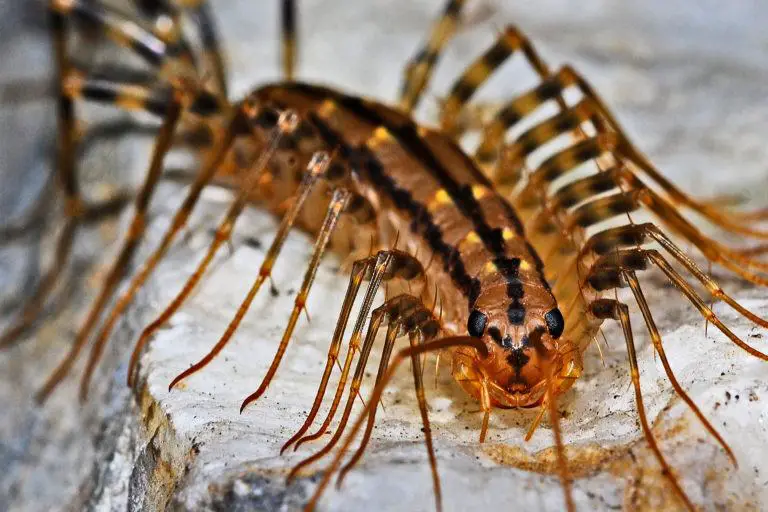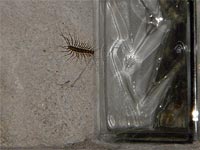
I first encountered a house centipede when I was 12. I saw it on my way to bed one night, crouching on the wall above the stairs. I stood motionless, staring at it while I decided whether to wake my dad to ask him what that thing was, and to kill it for me. I’m notoriously phobic of creepy-crawlies, and was shaken enough to decide that waking my dad after midnight because of a bug that looked like this one was justifiable. He disagreed. Before going back to bed (leaving the centipede undisturbed), he told me that they crawl all over you and bite you while you sleep. The next morning, in a slightly repentant mood, he told me that this probably wasn’t true. Turns out, it’s not. Centipedes rarely bite people, and sometimes their jaws aren’t even strong enough to pierce human skin in self-defense. If they manage it, a centipede bite will usually resemble a minor bee sting in a human or large mammal like a cat or dog.
The only creatures that need to worry about house centipedes are their fellow pests, since centipedes kill and eat a variety of things you’d probably rather get rid of, like bed bugs, termites, silverfish, spiders, and even cockroaches. Technically, then, they’re desirable in the home, but people have been telling me that about spiders for years, yet I don’t want to find one of them in the shower with me, either. So if you’re like me, read on, and I’ll help you get rid of centipedes.
What is a Centipede?
 There are more than 2,000 species of centipede in the world, most of which live almost exclusively outdoors. The kind we’re talking about is the house centipede, scientific name Scutigera coleoptrata, the only species that can live its entire life and breed inside a building. The species is probably native to the Mediterranean region, but has made its way around the world thanks to international trade and travel.
There are more than 2,000 species of centipede in the world, most of which live almost exclusively outdoors. The kind we’re talking about is the house centipede, scientific name Scutigera coleoptrata, the only species that can live its entire life and breed inside a building. The species is probably native to the Mediterranean region, but has made its way around the world thanks to international trade and travel.
Centipedes are arthropods like insects, but they aren’t actually insects, since they have more than six legs (by far; the house centipede has an average of 30 when full-grown). They lay eggs—usually between 50 and 100—in the spring, and can live a relatively long time: 3-7 years. They spend most of the day hiding in dark places, and come out at night to hunt for small prey. Because they have to remain in a damp environment to keep from drying out, they are often found outdoors under rocks, tree bark, and leaves, and indoors in basements and bathrooms.
Best Methods for House Centipede Control
Kill centipedes or capture them on sight—if you can.
Their rigid bodies and freakishly long, numerous legs make them very fast. But centipedes don’t usually invade homes in enormous numbers, so if you don’t see them often and you eliminate the one you’re looking at, you may have just taken care of your centipede problem. If you don’t want to kill the centipede, but you want it out of your space, you can capture it in a jar and take it outside. Otherwise, spraying it with an aerosol insecticide that claims to kill centipedes—or simply squishing it—will do the trick.
Get rid of other small household pests,
and centipedes will move to someone else’s house, where there’s more to eat.
Keep your house dry.
Centipedes dry out and die if they don’t stay in a moist environment, so if you clean up damp closets and basements, and use dehumidifiers, centipedes will find a more hospitable place to live.
Use sticky traps.
Put them in corners along the floorboards, where centipedes often hunt, and the traps will capture not only centipedes, but house insects as well. This will help you determine which other pests you need to eliminate, to deprive the centipedes of prey. You can order these sticky traps from Victor at Amazon.
Close off entrance points.
Keep centipedes from entering your house in the first place by sealing cracks in the foundation and concrete walls, eliminating spaces around doors and windows, and covering basement floor drains with window screen. This will help with other home invading bugs too.
Chemical Centipede Extermination
If you aren’t satisfied with just keeping these creepy-crawlies out of your space, and you want to know how to kill centipedes, keep reading. If your only beef is with centipedes inside your house, you can put a powdered residual insecticide such as Drione in the places where centipedes usually hide, like in wall cracks, dark corners of the basement, crawl spaces, and under furniture. Keep in mind that centipedes will have to walk across an insecticide accidentally; because they usually go after moving prey, they aren’t susceptible to baits.
You can discourage centipedes from even going near your home by coating the bottom few feet of the side of your house, and soaking at least a five-foot band of soil around the house, with an outdoor residual spray insecticide such as Talstar or Demon WP. If you don’t even want to encounter centipedes in your yard, be sure to spray the whole lawn and any mulch you use for gardening or landscaping. Remember, though, that insecticides alone will only work temporarily and often are detrimental to helpful bugs like honeybees. If your yard and house are still cluttered, damp, and full of tasty bugs, the centipedes will find you again.
Best Natural Centipede Control Methods
Actually, most methods of getting rid of centipedes are natural ones. I’ll provide a couple of additional suggestions here, but some natural solutions—like keeping your house dry and sealing potential points of entry—are detailed in the center of the page.
Reduce clutter, inside the house and out.
If your laundry isn’t on the floor, centipedes will be forced to find another hiding place. Outside, keep leaf litter, grass clippings, firewood, compost, and building materials cleaned up or away from the perimeter of the house. If you really hate centipedes (and you aren’t renting), you may even go so far as to tear down any ivy growing up the side of your house. Centipedes love to hide in it.
If you want to poison the centipedes, but you don’t want to poison the earth, yourself, or your pets.
You can use natural pesticides like boric acid or food grade diatomaceous earth for continual centipede control. Products containing plant-derived pyrethrin will exterminate centipedes on contact, and can be used as a fog or spray. You can get a 10 lb bag of diatomaceous earth from Amazon for a decent price.